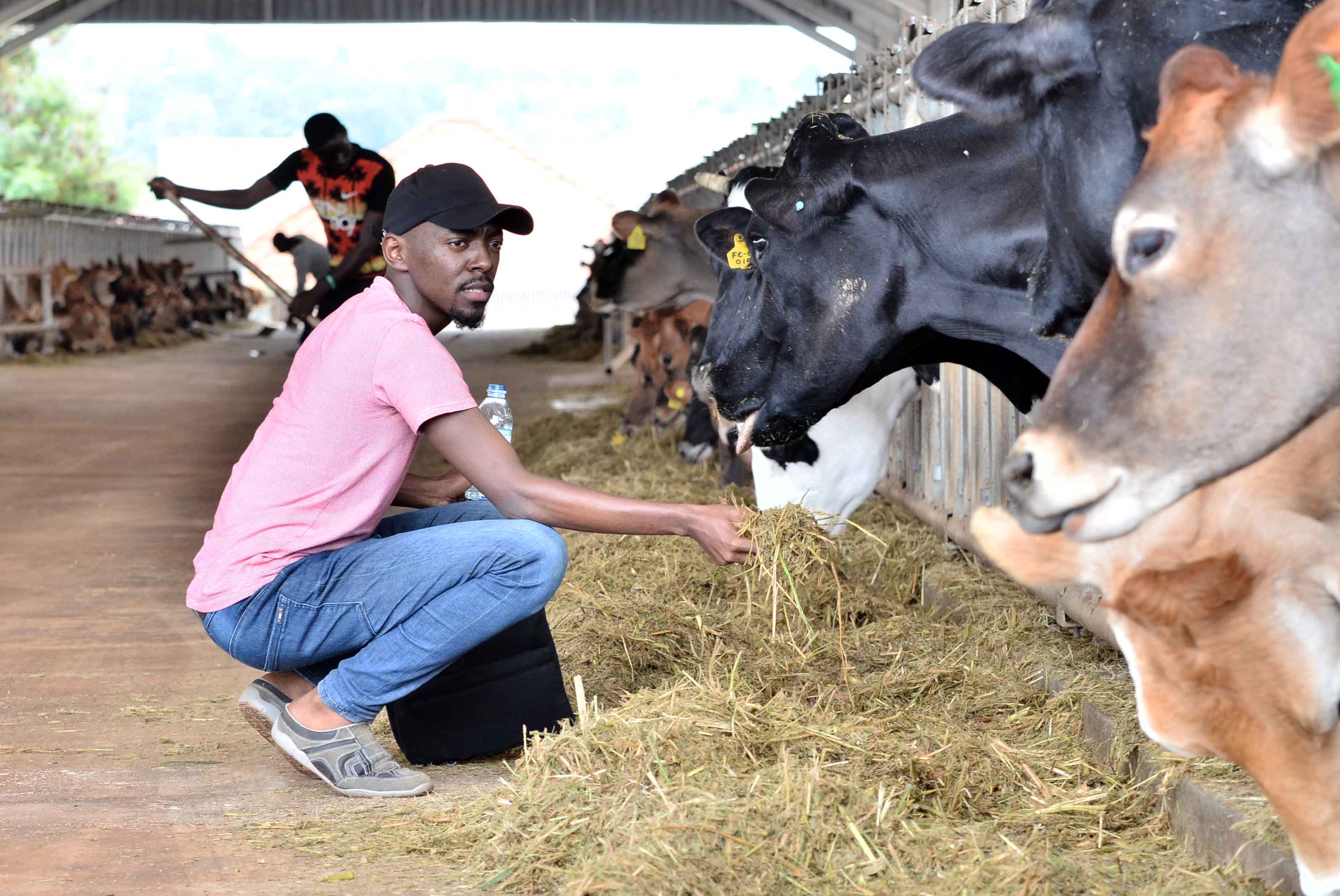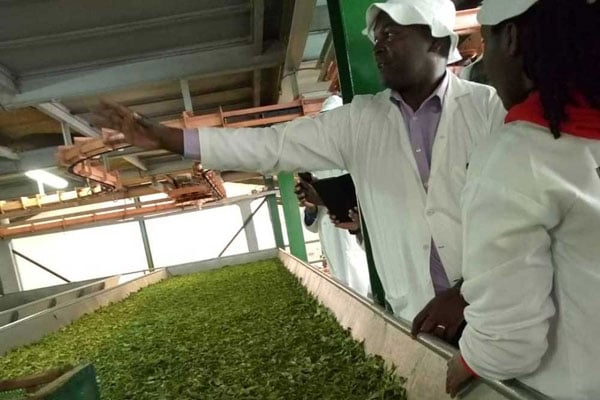Prime
Energy efficiency as a means to reduce farm costs

Seeds of Gold’s David Ajuna feeds a dairy cow during a recent Seeds of Gold Farm Clinic at Namulonge. A naturally well-lit cow shade is important in saving energy. NARO and NaLLIRI experts urge value addition. PHOTO/GEORGE KATONGOLE
What you need to know:
- Farm operations use energy to heat, cool, plant, harvest, clean, and perform a wide variety of tasks. However, the price of energy can sometimes be a real obstacle to keeping a farm profitable.
Fifteen percent of agricultural production costs are estimated to be energy-related and as energy prices rise, these costs claim an even bigger portion of farm budgets.
The quickest, cheapest and cleanest way to lower these costs is by improving energy efficiency.

An energy efficient farm at Nakyesasa which has efficient equipment and a well aerated environment. The roof has skylights which improve lighting during day. Photo/George Katongole
According to Jacob Etunganan, an energy consultant with the Netherlands Development Organisation (SNV), farm businesses need to look at energy efficiency schemes to boost income.
Farms use energy in a variety of forms - electricity, fuel, and natural gas are the common sources of energy.
Renewable energy resources, such as biogas or biomass, can also be produced as well as used on the farm.
However, they must all be used effectively if a farm’s profitability is to be maximised.
Reducing the amount of electricity used around the farm helps keep them profitable.
Farmers who have implemented recommended energy efficient practices, Etunganan says, have seen, on average, a 40 per cent reduction in their energy costs.
Etunganan says energy efficiency is often a very cost-effective energy resource.
“Expenditure on energy could be cut by 10-15 per cent by using energy more efficiently, educating staff/workers and by buying smarter. This requires no capital investment,” says Etunganan.
He says that efficiency efforts can help to ensure that reliable power is provided to the maximum number of customers at a lower cost than would be required to increase generation alone.
A 2016 report on electricity peak demand in Uganda indicates that integrating energy efficiency and using the most efficient technologies, 442MW of generation-level demand could be offset and energy access for an additional six million rural customers could be achieved by 2030.
Of this technical potential for efficiency, 91 per cent is cost-effective, and 47 per cent is economically achievable under conservative assumptions.
Catalytic action
Through the Inclusive Markets for Energy Efficiency in Uganda (IMEU) a four-year project funded by the Embassy of Sweden, SNV aims at increasing adoption of energy efficient products and services in agriculture and the built environment.
SNV’s strategy is intertwined with a sustainable sector development approach aimed at developing a socially inclusive ecosystem for energy efficiency, combined with targeted support to SMEs and Energy Service Companies (ESCos).
The project is implemented by a consortium led by SNV with support from Makerere University College of Engineering, Design, Art and Technology (CEDAT) and Private Sector Foundation Uganda (PSFU) as implementing partners.
The project focuses on the prioritised agricultural value chains of tea, maize, sunflower and soya bean and the built environment targeting industrial, public, and commercial buildings across 11 districts and three cities in the country.
The project covers the districts of Bushenyi, Buhweju, Kanungu, Kabarole, Lira, Oyam, Kole, Dokolo, Wakiso, Kampala and Mukono. Tea will be prioritised for the Western region, sunflower and soya bean for the northern part, and maize will cut across all the selected districts.
Saving money
The most important step in improving a farm’s energy efficiency is to understand the current energy consumption.
A careful assessment of the farm’s energy use is necessary to understand where the energy is being used.
Etunganan says it is not uncommon to find unexpected energy wasters, especially equipment or processes that use more energy than they should.
Once the existing energy usage is determined, it is time to figure out the changes that can be made to reduce energy use. These changes are often referred to as “energy conservation measures” or ECMs.
Energy conservation measures can be as simple as changing a lighting setting or as complex as replacing multiple pieces of equipment with more efficient devices.
Etunganan says that generating a list of energy conservation measures at farm level is not always an easy process as it often requires experts.
Simple procedures, such as keeping farm equipment engines tuned, can save fuel. Clogged air and fuel filters and injectors burn more fuel, as do motors or engines with rusty or corroded parts, among others. Dirty fans, for instance, can be up to 40 percent less efficient.
Etunganan explains that replacing incandescent bulbs with LED lights in barns not only reduces energy use, but saves farmers money.
Modifying irrigation systems can also reduce energy and costs. Switching from high to low-pressure sprinkler systems can save about 770 kWh per acre annually. In areas where ground and surface water is diminishing, efficient irrigation tools such as drip, trickle and lower-flow sprinkler systems save energy, water and money.
Etunganan adds that in the built farm environment, windows should be properly sited while operable windows and skylights can enhance ventilation and cooling.
The most common way to compare ECMs is to calculate the number of years that it takes for the savings of an ECM to cover the cost of installation. Shorter paybacks tend to be better, with four to five years often considered the maximum for commercial operations.
The energy experts can advise on the options and how they can improve the performance of the farm. “The power plan should be assessed to ensure that it is worth it in the long run,” Etunganan says.
Other options
Reducing energy use is not the only way to save on the energy bill and make the farm more profitable. Etunganan says that there are other strategies that involve changing the way people use energy that could also yield savings.
One of the ways, he says, is to control electricity usage during the day, in order to reduce costs.
He says that farm operations should be able to increase consumption at non-peak times. The current peak tariff is 20 percent above shoulder tariff and off-peak is 20 percent less shoulder tariff.
Peak consumption is between 6pm-midnight while off-peak tariff is billed between midnight and 6am.
“It is possible for agro-processors and farm activities to adjust their operating schedule to off-peak hours to reduce their electricity bill,” he says. Many dairy farms heavily rely on power mostly for collecting and cooling milk, heating water and lighting. Increasing the energy efficiency in the dairy value chain implies using also its by-products.
Cattle manure can be used for biogas production, which can generate heat for cooking, heating, electricity – which in turn can power cooling systems and hence prevent spoilage of milk.Studies show that from one tonne of cow manure, the biogas produced can generate around 125kWh of electricity.
Another possibility is to grow energy crops such as maize and sugarcane, which are one of the main sources of biomass-based feedstocks that can be used for biofuel production.
Overcoming the barriers
The main barriers to upscale energy effective solutions in the agriculture value chain are the high upfront cost of technology combined with a lack of financing mechanisms.

An efficient rice mill saves energy. Photo/George Katongole
The other barrier is the lack of awareness of available technology among farmers and cooperatives.
This supports the argument for the deployment of other awareness raising efforts and of energy efficient solutions in the value chain.
However, small dairies are less likely to have access to the knowledge and capital required to invest in modern technology.
Enhancing access to finance may allow farmers to invest in energy efficient and clean energy solutions, which would lead to reduced costs, and increase farmers’ incomes.
The IMEU Market Development Fund addresses access to finance by energy service providers.
The MDF fund aims to mitigate risks and eliminate barriers that prevent companies from launching new ventures.
It is designed to support all companies meeting basic eligibility criteria and to stimulate access to energy efficient services.
Manure
Cattle manure can be used for biogas production, which can generate heat for cooking, heating, electricity – which in turn can power cooling systems and hence prevent spoilage of milk.
SDG 7
Ensure access to affordable, reliable, sustainable and modern energy for all.




